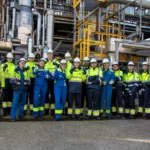A portfolio of Sustainable Development Indicators (SDIs) has been developed to track the chemical industry’s transition toward a safe, resource-efficient, and circular economy within a climate-neutral Europe. These indicators assess both the industry’s transition progress and its sustainability performance.
The SDIs reflect those used by the UN and the EU to monitor the success of policies such as the Chemicals Strategy for Sustainability, the Circular Economy Action Plan, and the Chemical Industry Transition Pathway.
The chemical industry is central to advancing the 17 UN Sustainable Development Goals and supporting access to decent living standards for a projected 9.7 billion people by 2050, all while respecting the planetary boundaries.
The key sustainability performance areas (listed below) align closely with Responsible Care®. This global initiative reflects the chemical industry’s commitment to continuous improvement in environmental, health, safety, and security performance, going beyond legislative and regulatory requirements.
- Climate: The Paris Agreement, the global treaty on climate change, sets a global target that requires significant efforts from all sectors. The European chemical industry aims to embrace both the opportunities and challenges of transitioning to climate-neutrality and circularity.
- Circularity: The chemical industry strives to increase resource efficiency in processes, materials, and products across global value chains and its own operations. By adopting circular economy principles, guided by the 10 R-strategies, which focus on smarter product use and manufacture, extension of product lifespan and useful material application – and integrating low carbon economy goals with natural resource conservation, the industry aims to redesign products and operations to be restorative and regenerative by design.
- People: Caring for both consumers and workers is a continuous focus of the chemical industry. By addressing safety and sustainability throughout the entire life cycle of chemicals, the industry aims to produce safer and more sustainable substances, materials, and solutions.
- Environment: The chemical industry is dedicated to protecting the planet, with a focus on biodiversity and ecosystems. By operating within the planetary boundaries and implementing practices that minimise environmental impact, the industry strives to create a more sustainable world. This includes efforts to reduce emissions, manage waste, and use resources more efficiently, all aimed at preserving natural habitats and maintaining ecological balance.
- Prosperity: A thriving EU chemical industry is instrumental for the success of achieving the European green and digital transition. EU industry competitiveness is necessary as a driver for continuous innovation and improvement. Strong economic competitiveness is essential in both the short and long term to drive prosperity and enable a successful and sustainable transition.
- Governance: By implementing good governance practices, the EU chemical industry is able to perform efficiently and responsibly. Balancing intricate regulatory frameworks, complex value chains and rapid innovation, the EU chemical industry has set robust frameworks and initiatives to improve its governance structure.
The list of SDIs is a set of indicators mapping the performance related to some of the key industry activities. This set will be further developed to represent all key industry activities.
Disclaimer :
This report is made in good faith based on the information available at the date of publication. However, Cefic does not make any representations or warranties as to its accuracy or completeness. No liability will be accepted by Cefic or its members for any damages whatsoever resulting from the interpretation, use, or reliance on its contents.













